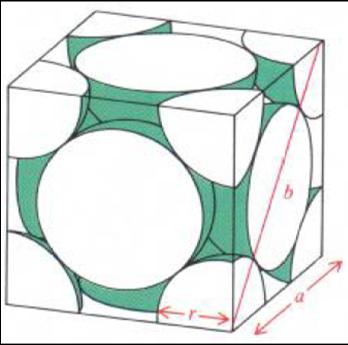Question #dfe68
1 Answer
Explanation:
The idea here is that you need to use the atomic weight of nickel to determine the mass in grams of a single nickel atom, then use the characteristics of a face-centered cubic lattice to determine what the mass of a unit cell is.
Once you know that, use the given density to determine the unit cell's volume.
So, the unified atomic mass unit,
#"1 u" = 1.660539 * 10^(-27)"kg"#
This means that the mass of a single nickel atom, expressed in grams, will be
#58.7color(red)(cancel(color(black)("u"))) * (1.660539 * 10^(-27)color(red)(cancel(color(black)("kg"))))/(1color(red)(cancel(color(black)("u")))) * "1000 g"/(1color(red)(cancel(color(black)("kg")))) = 9.75 * 10^(-23)"g"#
Now, a face-centered cubic lattice is characterized by the fact that it contains a total of
- a total of eight lattice points that correspond to the corners of the unit cell
- a total of six lattice points that correspond to the faces of the unit cell
Now, the corner lattice points will each contain

This means that you can estimate the total number of atoms that fit in a face-centered cubic cell by using
#"no. of atoms" = overbrace(1/8 xx 8)^(color(red)("8 corners")) + overbrace(1/2 xx 6)^(color(green)("6 faces")) = "4 atoms"#
Use the mass of single nickel atom to estimate the mass of a cubic unit cell**
#9.75 * 10^(-23)"g"/color(red)(cancel(color(black)("atom"))) * (4color(red)(cancel(color(black)("atoms"))))/"unit cell" = 3.9 * 10^(-22)"g/unit cell"#
Now that you have an idea about what the mass of a unit cell is, you can use nickel's density to determine what its volume would be.
#3.9 * 10^(-22)color(red)(cancel(color(black)("g"))) * overbrace( "1 cm"^3/(8.9color(red)(cancel(color(black)("g")))))^(color(blue)("density")) = 4.38 * 10^(-23)"cm"^3#
Finally, the volume of a cube is given by the formula
#color(blue)(V = l xx l xx l = l^3)" "# , where
This means that the length of the unit cell will be equal to
#V = l^3 implies l = root(3)(V)#
#l = root(3) ( 4.38 * 10^(-23)"cm"^3) = 3.5 * 10^(-8)"cm"#
If you want, you can convert this value to picometers by using the fact that
#"1 pm" = 10^(-12)"m" = 10^(-10)"cm"#
#3.5 * 10^(-8)color(red)(cancel(color(black)("cm"))) * "1 pm"/(10^(-10)color(red)(cancel(color(black)("cm")))) = color(green)("350 pm")#
The answer is rounded to two sig figs, the number of sig figs you have for the density of nickel.

